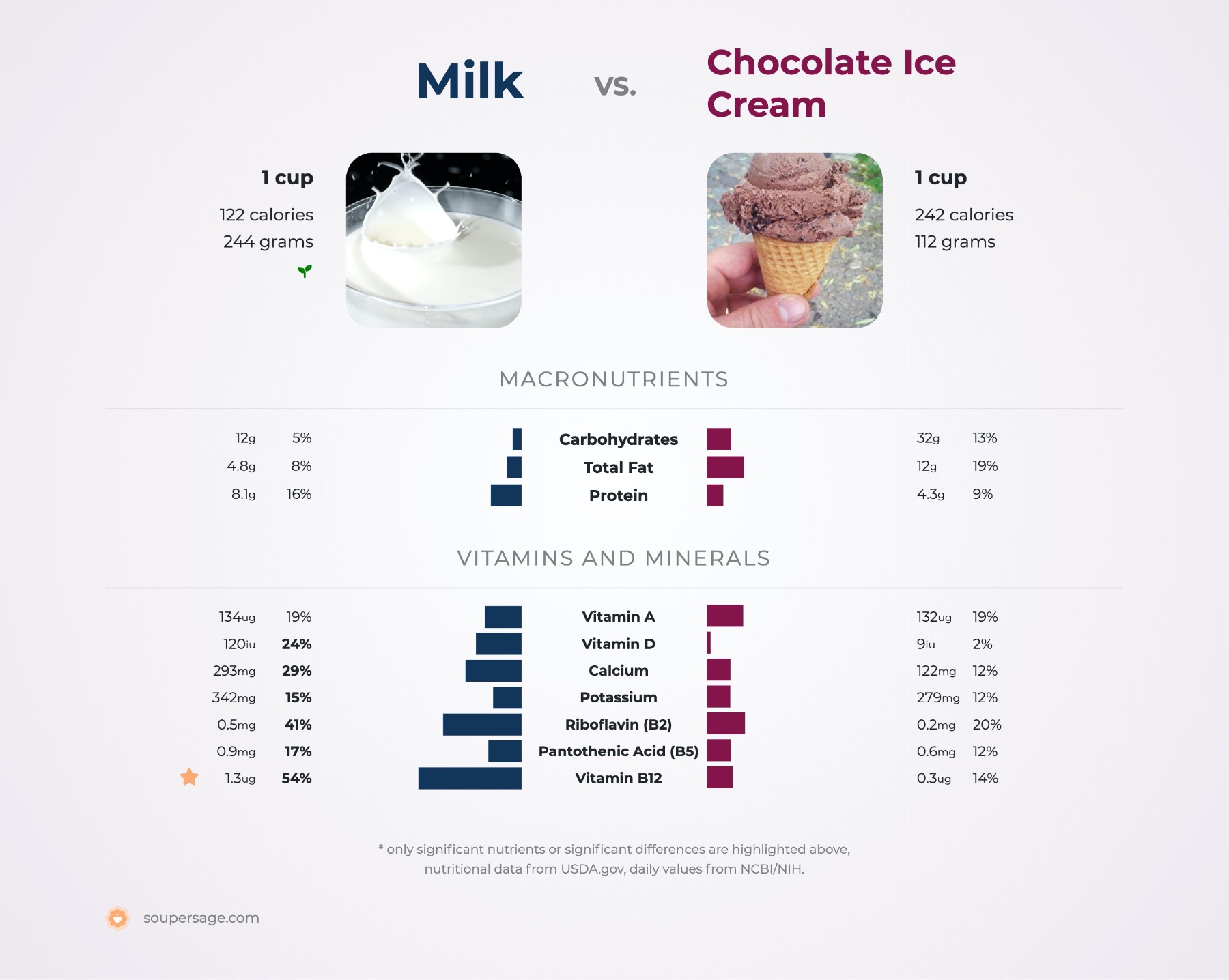Milk vs. Chocolate Ice Cream
Nutrition comparison of Milk and Chocolate Ice Cream
Ever wonder how your favorite foods stack up against each other in terms of nutrition?
We compared the nutritional contents of
milk
versus
chocolate ice cream
(100g each)
below using 2020 USDA and NIH data[1].
For a quick recap of significant nutrients and differences in milk and chocolate ice cream:
- Both chocolate ice cream and milk are high in calcium.
- Chocolate ice cream has more folate.
- Chocolate ice cream is a great source of Vitamin A and potassium.
- Milk has signficantly less carbohydrates than chocolate ice cream.
USDA sources for nutritional information: Milk (Milk, reduced fat, fluid, 2% milkfat, with added vitamin A and vitamin D) and Chocolate Ice Cream (Ice creams, chocolate) . Have a correction or suggestions? Shoot us an email.
Calories and Carbs
calories
Chocolate ice cream is high in calories and milk has 77% less calories than chocolate ice cream - chocolate ice cream has 216 calories per 100 grams and milk has 50 calories.
For macronutrient ratios, milk is heavier in protein, lighter in carbs and lighter in fat compared to chocolate ice cream per calorie. Milk has a macronutrient ratio of 26:38:36 and for chocolate ice cream, 7:50:44 for protein, carbohydrates and fat from calories.
Macro Ratios from Calories:
| Milk | Chocolate Ice Cream | |
|---|---|---|
| Protein | 26% | 7% |
| Carbohydrates | 38% | 50% |
| Fat | 36% | 44% |
| Alcohol | ~ | ~ |
carbohydrates
Milk has signficantly less carbohydrates than chocolate ice cream - chocolate ice cream has 28.2g of total carbs per 100 grams and milk has 4.8g of carbohydrates.
dietary fiber
Chocolate ice cream has more dietary fiber than milk - chocolate ice cream has 1.2g of dietary fiber per 100 grams and milk does not contain significant amounts.
sugar
Chocolate ice cream is high in sugar and milk has 80% less sugar than chocolate ice cream - chocolate ice cream has 25.4g of sugar per 100 grams and milk has 5.1g of sugar.
Protein
protein
Chocolate ice cream and milk contain similar amounts of protein - chocolate ice cream has 3.8g of protein per 100 grams and milk has 3.3g of protein.
Fat
saturated fat
Chocolate ice cream is high in saturated fat and milk has 82% less saturated fat than chocolate ice cream - chocolate ice cream has 6.8g of saturated fat per 100 grams and milk has 1.3g of saturated fat.
trans fat
Both milk and chocolate ice cream are low in trans fat - milk has 0.09g of trans fat per 100 grams and chocolate ice cream does not contain significant amounts.
cholesterol
Chocolate ice cream and milk contain similar amounts of cholesterol - chocolate ice cream has 34mg of cholesterol per 100 grams and milk has 8mg of cholesterol.
Vitamins
Vitamin C
Chocolate ice cream and milk contain similar amounts of Vitamin C - chocolate ice cream has 0.7mg of Vitamin C per 100 grams and milk has 0.2mg of Vitamin C.
Vitamin A
Chocolate ice cream is a great source of Vitamin A and it has 115% more Vitamin A than milk - chocolate ice cream has 118ug of Vitamin A per 100 grams and milk has 55ug of Vitamin A.
Vitamin D
Milk has 513% more Vitamin D than chocolate ice cream - chocolate ice cream has 8iu of Vitamin D per 100 grams and milk has 49iu of Vitamin D.
Vitamin E
Chocolate ice cream and milk contain similar amounts of Vitamin E - chocolate ice cream has 0.3mg of Vitamin E per 100 grams and milk has 0.03mg of Vitamin E.
Vitamin K
Chocolate ice cream and milk contain similar amounts of Vitamin K - chocolate ice cream has 0.3ug of Vitamin K per 100 grams and milk has 0.2ug of Vitamin K.
The B Vitamins
Chocolate ice cream has more folate. Both milk and chocolate ice cream contain significant amounts of thiamin, riboflavin, niacin, pantothenic acid, Vitamin B6 and Vitamin B12.
| Milk | Chocolate Ice Cream | |
|---|---|---|
| Thiamin | 0.039 MG | 0.042 MG |
| Riboflavin | 0.185 MG | 0.194 MG |
| Niacin | 0.092 MG | 0.226 MG |
| Pantothenic acid | 0.356 MG | 0.554 MG |
| Vitamin B6 | 0.038 MG | 0.055 MG |
| Folate | 5 UG | 16 UG |
| Vitamin B12 | 0.53 UG | 0.29 UG |
Minerals
calcium
Both chocolate ice cream and milk are high in calcium. Milk has a little more calcium (10%) than chocolate ice cream by weight - chocolate ice cream has 109mg of calcium per 100 grams and milk has 120mg of calcium.
iron
Chocolate ice cream has 45 times more iron than milk - chocolate ice cream has 0.93mg of iron per 100 grams and milk has 0.02mg of iron.
potassium
Chocolate ice cream is a great source of potassium and it has 78% more potassium than milk - chocolate ice cream has 249mg of potassium per 100 grams and milk has 140mg of potassium.
Antioxidants and Phytonutrients
carotenoids
Carotenoids are micronutrients commonly found in plants and some animal products. An example is beta-carotene, the notable carotenoid which is a popular source of Vitamin A.[4][5]
For specific types of carotenoids, both milk and chocolate ice cream contain small amounts of beta-carotene.
| Milk | Chocolate Ice Cream | |
|---|---|---|
| beta-carotene | 4 UG | 19 UG |
Omega-3 and Omega-6
omega 3s
For omega-3 fatty acids, chocolate ice cream has more alpha linoleic acid (ALA) than milk per 100 grams.
| Milk | Chocolate Ice Cream | |
|---|---|---|
| alpha linoleic acid | 0.008 G | 0.15 G |
| Total | 0.008 G | 0.15 G |
omega 6s
Comparing omega-6 fatty acids, chocolate ice cream has more linoleic acid than milk per 100 grams.
| Milk | Chocolate Ice Cream | |
|---|---|---|
| other omega 6 | 0.004 G | ~ |
| linoleic acid | 0.062 G | 0.25 G |
| Total | 0.066 G | 0.25 G |
Customize your serving size
The comparison below is by weight, but sometimes 100g isn't that intuitive of a measurement for food. View a custom portion comparison (e.g. cups, oz, package).
You can try adding or subtracting the amount of either Milk or Chocolate Ice Cream .
Note: The specific food items compared are: Milk (Milk, reduced fat, fluid, 2% milkfat, with added vitamin A and vitamin D) and Chocolate Ice Cream (Ice creams, chocolate) .
Milk g
()
|
Daily Values (%) |
Chocolate Ice Cream g
()
|
|||||
|---|---|---|---|---|---|---|---|
| KCAL % |
|
5% | calories | 5% |
|
KCAL % | |
| G % |
|
5% | carbohydrates | 5% |
|
G % | |
| G % |
|
5% | dietary fiber | 5% |
|
G % | |
| G | 5% | sugar | 5% | G | |||
| G % |
|
5% | total fat | 5% |
|
G % | |
| G % |
|
5% | saturated fat | 5% |
|
G % | |
| G | 5% | monounsaturated fat | 5% | G | |||
| G | 5% | polyunsaturated fat | 5% | G | |||
| G | 5% | trans fat | 5% | G | |||
| MG | 5% | cholesterol | 5% | MG | |||
| MG % |
|
5% | sodium | 5% |
|
MG % | |
| 5% | Vitamins and Minerals | 5% | |||||
| UG % |
|
5% | Vitamin A | 5% |
|
UG % | |
| MG % |
|
5% | Vitamin C | 5% |
|
MG % | |
| IU % |
|
5% | Vitamin D | 5% |
|
IU % | |
| MG % |
|
5% | calcium | 5% |
|
MG % | |
| MG % |
|
5% | iron | 5% |
|
MG % | |
| MG % |
|
5% | magnesium | 5% |
|
MG % | |
| MG % |
|
5% | potassium | 5% |
|
MG % | |
| MG % |
|
5% | thiamin (Vit B1) | 5% |
|
MG % | |
| MG % |
|
5% | riboflavin (Vit B2) | 5% |
|
MG % | |
| MG % |
|
5% | niacin (Vit B3) | 5% |
|
MG % | |
| MG % |
|
5% | Vitamin B6 | 5% |
|
MG % | |
| MG % |
|
5% | pantothenic acid (Vit B5) | 5% |
|
MG % | |
| UG % |
|
5% | folate (Vit B9) | 5% |
|
UG % | |
| UG % |
|
5% | Vitamin B12 | 5% |
|
UG % | |
| MG % |
|
5% | Vitamin E | 5% |
|
MG % | |
| UG % |
|
5% | Vitamin K | 5% |
|
UG % | |
| G % |
|
5% | protein | 5% |
|
G % | |
| UG % |
|
5% | biotin (Vit B7) | 5% |
|
UG % | |
| MG % |
|
5% | choline | 5% |
|
MG % | |
| MG % |
|
5% | chlorine | 5% |
|
MG % | |
| UG % |
|
5% | chromium | 5% |
|
UG % | |
| MG % |
|
5% | copper | 5% |
|
MG % | |
| UG % |
|
5% | fluoride | 5% |
|
UG % | |
| UG % |
|
5% | iodine | 5% |
|
UG % | |
| MG % |
|
5% | manganese | 5% |
|
MG % | |
| UG % |
|
5% | molybdenum | 5% |
|
UG % | |
| MG % |
|
5% | phosphorus | 5% |
|
MG % | |
| UG % |
|
5% | selenium | 5% |
|
UG % | |
| MG % |
|
5% | zinc | 5% |
|
MG % | |
| G | 5% | Water | 5% | G | |||
| G | 5% | Starch | 5% | G | |||
| G | 5% | Alcohol | 5% | G | |||
FAQ
Does chocolate ice cream or milk contain more calories in 100 grams?Chocolate ice cream is high in calories and milk has 80% less calories than chocolate ice cream - chocolate ice cream has 216 calories in 100g and milk has 50 calories.
Does chocolate ice cream or milk have more carbohydrates?
By weight, milk has signficantly fewer carbohydrates than chocolate ice cream - chocolate ice cream has 28.2g of carbs for 100g and milk has 4.8g of carbohydrates.
Does chocolate ice cream or milk contain more calcium?
Both chocolate ice cream and milk are high in calcium. Milk has a little more calcium ( 10%) than chocolate ice cream by weight - chocolate ice cream has 109mg of calcium in 100 grams and milk has 120mg of calcium.


